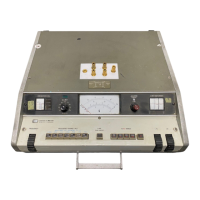Model 4342A
SECTION II
INSTALLATION
Section II
Paragraphs 2-l to 2-16
2-l. INTRODUCTION
2-2. This sectioncontains informationfor unpacking,
inspection, repacking, storage, and installation of the
Model 4342A.
2-3. INITIAL INSPECTION
2-4. MECHANICAL CHECK
2~5. If damage to the shipping carton is evident, ask
that the carrier’s agent be present when the instrument
is unpacked. Inspect the instrument for mechanical
damage. Also check the cushioning material for signs
of severe stress.
2-6. PERFORMANCE CHECKS
2-7. The electrical performance of the Model4342A
should be verified upon receipt. Performance checks
suitable for incoming inspectionare given in Section
V, Maintenance.
2-8. DAMAGE CLAIMS
2-9. If the instrument is mechanically damaged in
transit, notify the carrier and the nearest Hewlett-
Packard field office immediately. A list of field offices
is on the backof this manual. Retain the shipping car-
ton andpadding material for the carrier’s inspection.
The fieldoffice will arrange for replacement or repair
of your instrument without waiting for claim settle-
ments against the carrier.
2-10. Before shipment this instrument was inspected
and found free of mechanical and electrical defects.
If there is any deficiency, or if electrical performance
is not within specifications, notify your nearest
Hewlett-Packard Sales and Service Office.
2-11. STORAGE AND SHIPMENT
2-12. PACKAGING. To protect valuable electronic
equipment during storage or shipment always use the
best packaging methods available,
Your Hewlett-
Packard field office can provide packing material such
as that used,for original factory packaging. Contract
packaging companies in many cities can provide de-
pendable custom packaging on short notice. Here are
a few recommended packaging methods :
a. RUBBERIZED HAIR.
Cover painted surfaces
of instrument with protective wrapping paper.
Pack instrument securely in strong corrugated
container (350 lb/sq in. bursting test) with 2-
inch rubberized hair pads placed along all sur-
faces of the instrument. Insert fillers between
pads and container to ensure a snug fit.
b. EXCELSIOR. Cover painted surfaces of instru-
ment with protective wrapping paper. Pack in-
strument in strong corrugated container (350 lb/
sq in. bursting test) with a layer of excelsior
about 6 inches thick packed firmly against all
surfaces of the instrument.
2-13. ENVIRONMENT. Conditions during storage
and shipment should normally be limited as follows:
a. Maximum altitude, 20,000 feet
b. Minimum temperature, -40” F (-40” C)
C.
Maximum temperature, 167” F (75°C)
2-14.
2-15.
from
POWER CONNECTION
LINE VOLTAGE. The Model 4342Aoperates
either 115 or 230 volt (*lo%) ac line voltage
and Line frequency from 50 to 400Hz. A slide
switch on the rear panel permits quick conversion for
operating from either voltage. Insert a narrow- blade
screwdriver in the switch slot and slide the switch
to
the right for 115-volt operation (“115” marking ex-
posed) or to the left for 230-voltoperation (“230” mar-
king exposed). The Model 4342A is supplied with 115-
volt fuse; for 230-volt operation, be sure to replace
this fuse with that listed in Table 2-I.
Table 2-l. AC Line Fuse
Conversion 115-volt
Slide Switch Right
(“115’)
AC Line Fuse 0.6 amperes
Slow-Blow
2110-0339
CAUTION
230-volt
Left
(“230”)
0.3 amperes
Slow-Blow
21 lo-0044
To avoiddamage to theinstrument, before
connecting the power cable, set the 115/
230-volt switch for the line voltage to be
used.
2-16. POWER CABLE, To protect operating per-
sonnel, the National Electrical Manufacturers Associ-
ation (NEMA) recommends that instrument panels and
cabinets be grounded. Accordingly, the Model 4342A
is equipped with a detachable three.-conductor power
cable which, when plugged into an appropriate recepta-
cle, grounds panel and cabinet. The offset pin of the
three-prong connector is the ground pin. Proceed as
follows for power cable installation.
a. Connect flatplug (3-terminal connector) to LINE
jack at rear of instrument.
b. Connect plug (a-blade with round grounding pin)
to J-wire (grounded) power outlet. Exposed
2-l

